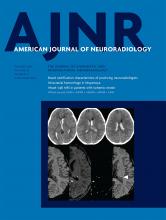Abstract
BACKGROUND AND PURPOSE: Flow disruption with the Woven EndoBridge is increasingly used for the treatment of intracranial aneurysms. We examined factors leading to aneurysm occlusion and Woven EndoBridge shape change during a midterm follow-up.
MATERIALS AND METHODS: Patients with a minimum 12-month angiographic follow-up were included. Through a univariate and multivariate analysis, independent predictors of adequate occlusion (Raymond-Roy 1/Raymond-Roy 2) and Woven EndoBridge shape change (decrease of the height of the device) were assessed.
RESULTS: Eighty-six patients/aneurysms were included. The aneurysm mean size was 5.5 mm (range, 3–11.5 mm). The most common locations were the MCA (43/86 = 50%), basilar tip (13/86 = 15.1%), and anterior communicating artery (12/86 = 14%). Twenty-one patients (21/86 = 24%) had acute SAH. Immediate and long-term Raymond-Roy 1/Raymond-Roy 2 occlusion rates were 49% (42/86) and 80% (68/86), respectively. Woven EndoBridge shape change was detected among 22% (19/86) of cases. At binary logistic regression, wide ostium (≥4 mm) (OR = 0.2; 95% CI, 0.01–1; P = .04) and regular aneurysm morphology (OR = 5.9; 95% CI, 1.4–24; P = .01) were independent factors of incomplete and adequate aneurysm occlusion, respectively. In addition, irregular morphology (OR = 5.4; 95%CI, 1.4–19; P = .01) and a wide ostium (OR = 9.8; 95% CI, 1.6–60; P = .03) significantly increased the probability of the Woven EndoBridge shape change. Decrease of the Woven EndoBridge height was more common among incompletely occluded aneurysms (6/12 = 50% versus 13/74 = 17.5%), but it was not an independent prognosticator of occlusion at the multivariate model.
CONCLUSIONS: The likelihood of good occlusion was 5 times lower in the presence of a wide ostium, whereas aneurysms with regular morphology were 6 times more likely to be occluded. Woven EndoBridge shape modification was strongly influenced by the aneurysm shape and ostium size, and it was not independently associated with the angiographic occlusion.
ABBREVIATIONS:
- AcomA
- anterior communicating artery
- BT
- basilar tip
- RR
- Raymond-Roy
- © 2019 by American Journal of Neuroradiology












